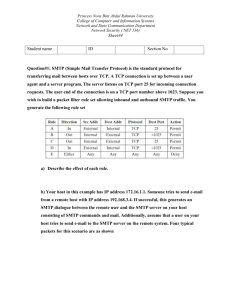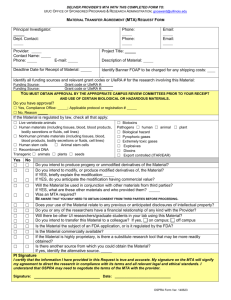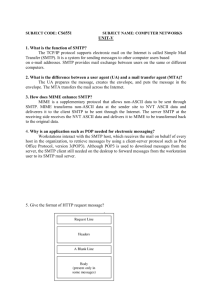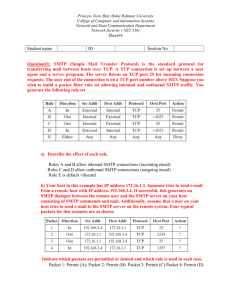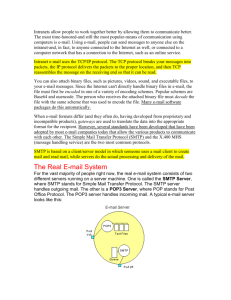DANE for SMTP
advertisement
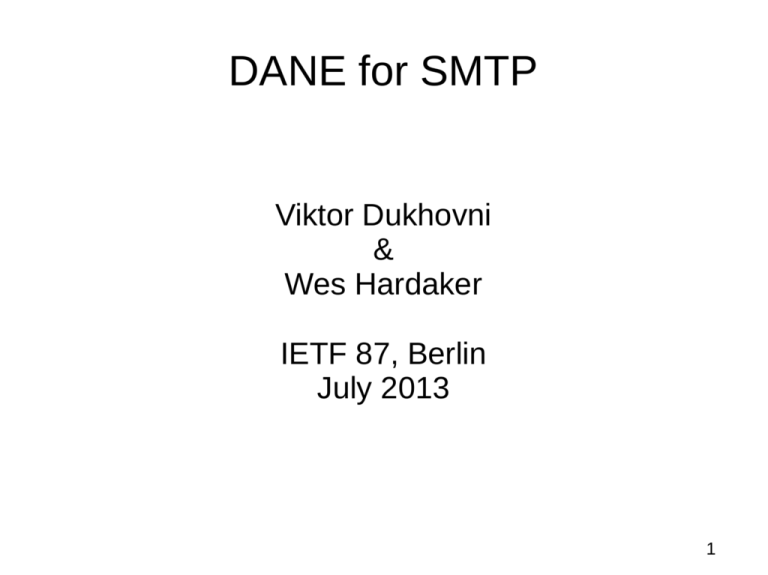
DANE for SMTP Viktor Dukhovni & Wes Hardaker IETF 87, Berlin July 2013 1 Addresses in SMTP ● <mailbox@example.com> is security agnostic: – SMTP with and without TLS runs over port 25 ● ● – SMTP is multi-hop store & forward ● ● ● ● – There is no URI scheme to designate “SMTP” vs. “SMTPS” STARTTLS is used to signal TLS support TLS is hop-by-hop SMTP addresses are NOT transport addresses Typical minimum number of hops is 3 Some may be protected, some may not MX RRs abstract hop destinations via DNS 2 7 3 1 7 Sending E-Mail Today 1 3 Sender’s MTA Email Author 1. Sender transmits to 2. MTA uses the their Mail Transfer receiver’s DNS Agent (MTA) “MX” records to find a destination MTA MX Pr ior SMTP ity #1 Excha nge MX Pr ior i ty #2 DNS Records 3. The sender’s MTA Receiver’s MTA sends email to the receiver’s MTA 3 7 4 1 7 Problem #1: Fake MX Records 1 3 Sender’s MTA Email Author #1 y t i r Prio hange X M Exc P Up-To-No-Good T SM Server MX Pr iority #2 MX Pr ior Maybe i ty Delivers #3 but May Not ‘Plain’ DNS Records Unfortunately, it is possible to create fake MX records, allowing an attacker to pretend to be the right “real” destination. Receiver’s MTA’s 4 7 5 1 7 Solution #1: DNSSEC 1 3 #1 y t i r Prio X M Sender’s MTA Email Author MX Pr iority #1 SMTP Excha nge MX Pr ior ity #2 Up-To-No-Good Server DNSSEC Protected Records DNSSEC ensures that only good DNS records are believable. Receiver’s MTA’s 5 7 6 1 7 Problem #2: Unprotected SMTP asy! E s I i ng p p o sdr e v a E 1 3 Sender’s MTA Email Author MX Pr iority #1 SMTP Excha nge MX Pr ior i ty #2 Most SMTP server to server exchanges are unencrypted. Receiver’s MTA 6 7 1 7 Solution #2: TLS-Protected SMTP 1 3 Sender’s MTA Email Author MX Pr iority #1 SMTP E MX xchange Pr ior i ty #2 SMTP can run over encrypted TLS, but: • Few servers do • Management of CA Trust Anchors is hard • MTA software doesn't distribute TAs Receiver’s MTA 7 7 8 1 7 Problem #3: SMTP Man-in-the-Middle 1 3 I don’t speak TLS, sorry! Sender’s MTA Up-To-No-Good Server Email Author SMTP over TLS uses the “STARTTLS” command • Man-in-the-middle allows for “I don’t support STARTTLS” • Current policy is to deliver unencrypted if TLS is unavailable Receiver’s MTA 8 7 9 1 7 Solution #3: SMTP over TLS with DANE 1 3 Sender’s ISP Email Author MX Pr iority #1 SMTP Excha nge MX Pr ior ity #2 A DANE record indicates you MUST use TLS! Receiver’s ISP 9 TLS and SMTP Summary ● MX/A... RRsets are insecure without DNSSEC ● Sender does not know when or how to use TLS – ● ● Except via administrative policy There is no user to click “OK” – Security must “just work” – With no “MUST use” signal, fallback to no-TLS STARTTLS allows for MITM downgrade attack 10 DANE and SMTP ● With DNSSEC and DANE we can: – Harden MX lookup via DNSSEC – Provide downgrade-resistant TLS support – Publish authentication public key digests (or keys) – Incremental adoption, without bilateral coordination! ● It turns on automatically when both sides support it 11 DANE and SMTP ● SMTP TLS security depends on DNSSEC – If DNSSEC is broken, all bets are off – CAs and TLS alone fail to secure the transport Usage 0 has same DNSSEC exposure as usage 2 – Usage 1 has same DNSSEC exposure as usage 3 ● ● Some MTAs (Exim and Postfix) have stated: – they may map 0 → 2 and 1 → 3 – Will have empty CA lists by default 12 SMTP Referral Choices ● ● Host SMTP yourself – Good: MX to your own internal name – Ehhh: No MX: CNAME to your mail host (legal) Outsource SMTP service – Good: MX exchange name to their name – Ehhh: No MX: Use CNAMEs (legal but discouraged) – Bad: Copy their A and TLSA records to your zone (and point MX to your copies) ● Don't do this anywhere (illegal): – Ugly: MX records point to a CNAME 13 SMTP hosting example ● Easy example - MX to the outsourced name: – In client.com's zone: client.com. IN MX 1 mx1.provider.com. – In provider.com's zone: mx1.provider.com. IN A …. _25._tcp.mx1.provider.com. IN TLSA … ● SNI: – – uses mx1.provider.com. Only a single certificate is needed (for “mx1.provider.com”) 14 TLSA records and MX records ● MX exchange name → TLSA base domain – This is the TLS transport end-point – Certificate peername: ● ● – The provider publishes the TLSA record for their keys ● – ● SHOULD be the TLSA base name MAY be the domain of the email address or configured transport domain The client simply points and doesn't publish data SNI not essential to support multiple client domains Operational guidance: – Use MX records this way! 15 DANE SMTP Model Summary ● Opportunistic and downgrade-resistant ● No interactive user: reliability must be paramount ● Trusts DNSSEC ● – Recommends type 3 and then 2 – Type 0 and 1 usage are undefined and SHOULD NOT be used Certificate chains MUST include the TA 16 What To Do With This Work? ● Merge content with draft-ietf-dane-smtp? ● Publish different components separately? 17 Extra Slides PKIX and SMTP ● Handy for bilateral secure-channels – Manually configured TLS expectation policies and keys – Explicit TLS requirement not dependent on competence of remote DNS operator – Explicit sender choice of (agreed upon) CA(s) – No bleeding edge code, tested TLS PKI. – However fragile when peer switches MX providers, CAs, etc. without notice. – Only viable for peer sites willing to coordinate infrastructure changes with sender! 19 SMTP Hosting With CNAMEs ● RFC 5321 Section 5.1: – ● If a CNAME record is found, the resulting name is processed as if it were the initial name. Many domains are MX-hosted by outside providers. – Almost always via MX RRs – CNAMEs are an edge case: ● ● – “bob@some-cname.example.com” is rare “mail.example.com IN MX 1 cname.example.com” is illegal Transport mappings, however, use CNAMEs ● My server directly maps example.com to smtp.example.net20 SMTP hosting via MX CNAME (illegal) ● ● MTAs may support RFC non-conformant CNAMEs in MX hostnames. Example, MX host a CNAME in provider's zone: – In client.com's zone: client.com. IN MX 1 mx1.provider.com – In provider.com's zone: mx1.provider.com. IN CNAME realmx.provider.com. realmx.provider.com. IN A 192.0.2.1 _25._tcp.realmx.provider.com. IN TLSA … ● Works with TLSA RR at either MX exchange name – Or CNAME target if MTA and DNS operator agree. 21 SMTP hosting via MX CNAME (illegal) ● Example, MX host a CNAME in client's zone: In client.com's zone: client.com. IN MX 1 mx.client.com. mx.client.com IN CNAME mx.provider.com. _25._tcp.mx.client.com. IN TLSA … ; (case I) – – In provider.com's zone: mx.provider.com. IN A 192.0.2.1 _25._tcp.mx.provider.com. IN TLSA … ; (case II) ● ● Case I (looking for a TLSA before CNAME expansion) problematic: – Provider must use a per-client certificate to match each client's MX base domain. – TLSA record must be copied/tracked from provider's server(s). Case II (looking for a TLSA record after CNAME expansion): – ● works just fine if MTA chases CNAMEs on MX records. Proposal: MTAs must chase CNAMEs to determine TLSA base name. 22 DNS and SMTP ● DNS trust unavoidable – Only place to store hop-by-hop security requirements – TLS Peername checks must trust the DNS ● – (they're pulling the peername from the MX record) Without DNSSEC: ● ● ● Spoofable MX records Downgrade vulnerable TLS No authentication 23 SMTP hosting and IP copying ● Harder example - MX points to an internal name: – In client.example.com's zone: client.com. IN MX 1 intmx.client.com. ; data copied from provider's records: intmx.client.com. IN A 192.0.2.1 ; provider's address _25._tcp.intmx.client.com. IN TLSA … ● Requires client copy outsource data – – – – Bad practice for A records Bad practice for TLSA records SNI scaling issues with large # of certificates Operational Guidance: Don't do this 24
